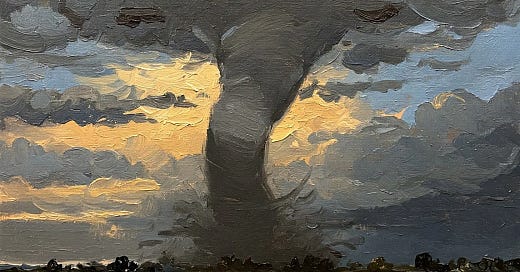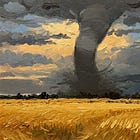Improve Your Storytelling with Foreshadowing and Folklore
Miniature writing lessons from my 100-word microfiction story, “Temperamental Twisters.”
One thing about living in the South Central United States that I just can’t get over: How the wind wants to kill me.
Where I grew up in Upstate New York, we didn’t have scary windstorms or tornadoes. So you can imagine the shock of moving to a place where tornadoes aren’t just an occasional occurrence, but a common one. While I have yet to experience a devastating storm in my part of the Kentucky Bluegrass region, I can’t help but wonder what it feels like to live through such an event.
This story, “Temperamental Twisters,” is in part inspired by these storms, but with an extra dose of the fantastic to keep things fresh.
To get inspiration and perspective to write this story, I examined firsthand experiences from those who have lived through a tornado. While these experiences vary, I recalled one particular experience that described the funnel cloud as “evil” and “green.” That description stuck with me, and it became the crux of the conflict in this story.
I hope you enjoy reading this reflection on “Temperamental Twisters.”
Read the story here (but make sure you come back for the Writer’s Note).
Breathtaking Imagery
And effective use of contrasting elements.
Look, I’m not the most confident writer in the world, but I do feel like I have a pretty solid grasp on imagery, and that comes through in “Temperamental Twisters.”
Right from the beginning, this story grounds the reader in the environment through its vivid imagery. One of my favorite descriptions is the “chest-high wheat field” and comparing it to an “amber ocean,” while the wind rolls across it like waves. It’s a peaceful scene, carefully designed to draw the reader in and later shatter their expectations.
The oncoming storm also makes effective use of sensory details to paint an ominous scene, one that’s in sharp contrast to the beautiful one before.
Especially in the second half of the story, I wanted to paint the wind as a menacing thing that fills the reader with a sense of dread. To this end, I used descriptors that built tension and illustrated the subtle shift in the wind. The “agitated breeze” transforms into a “sinister wind,” and the story culminates with the “evil green funnel” descending from the sky, cementing the wind as a serious, life-threatening thing.
By the end of the story, it’s clear that the wind can be both a peaceful presence and a destructive force, and it’s this dichotomy that drives the conflict of the story forward.
Little Timmy’s Purpose
Why does he want to capture the fairy?
There’s something about little Timmy and his sense of wonder at the fairy that brings me back to my childhood.
I wrote in a previous writer’s note about how we used to catch fireflies in bottles when we were kids, and this story channels a similar energy. In reflecting on this story, Timmy doesn’t have much of a purpose in doing so beyond simply wanting to. I’m unsure that he needs a purpose to catch the fairy–after all, he’s just a kid, and kids do things out of curiosity and impulse–but perhaps the story would be stronger if he had some kind of motivation to call upon here.
For example: What if Timmy’s mother told him a story about fairies? What if something was supposed to happen when he caught it?
Folklore can be a powerful worldbuilding tool, and when used correctly, it can even be used as a motivator for our characters’ actions. For example, one might avoid a graveyard out of superstition, or in contrast, one might visit a certain location to feel closer to nature or their fallen loved ones. If Timmy believes that catching a fairy will bring him luck or good health, he might have more incentive to capture it.
Of course, what happens after Timmy captures the fairy is beyond his expectations.
The Importance of External Feedback
And why you should pay attention to what others say.
“Temperamental Twisters” was recently featured on a podcast, and while the host’s description of the story was mostly spot-on, his quick summary of the story made me realize one major flaw.
I dropped the ball with the connection between the fairy and the tornado.
The tornado descending feels more like a coincidence rather than a consequence of Timmy’s actions. The tornado was actually caused by the fairy; it’s a spirit, a sylph, capable of manipulating atmospheric currents to generate anything from gentle breezes to severe storms, depending on its mood. What I thought was subtle foreshadowing with the “agitated breeze” was, in fact, unclear.
As for how to make this connection less of a reach, there are a couple of strategies I might employ, neither of which would impact the form factor of the story too much.
For one, it would help to establish somehow that this is indeed a wind spirit, either through naming it a sylph rather than a fairy or through a simple line of context. Perhaps there is a legend in Timmy’s village that if he catches one, something good will happen, which would make what actually happens even more of a shock. Another opportunity to make this more explicit would be to correlate the tornado with the sprite somehow, perhaps through some kind of action it takes while held captive in Timmy’s hands.
If you’re interested in reading more about what confinement might look like from the sylph’s perspective, see my previous story “The Endless Expanse.”
Opportunities for Improvement Abound
If only we had more words…
Despite this story’s strengths, “Temperamental Twisters” has several flaws that could be addressed to make it a more powerful little tale.
The presence of folklore or stories about fairies might provide Timmy with a motivation to capture the creature. Furthermore, it should have been made clear that this fairy is, in fact, a wind spirit, further cementing the conflict at the heart of this story. There are abundant opportunities here to adjust the pacing and inject more foreshadowing; it’s just a matter of weeding out unnecessary details and adding in more that enrich the story.
What are your thoughts? What lessons did you learn from this piece of microfiction? Let me know in the comments.
As always, thanks for reading, and until next time… Keep writing!
Cheers,
Josh
🚨 P.S. Want to learn more about how to write microfiction? Check out my 30-Day Microfiction Challenge. 🚨









I enjoyed your posts this morning. Reading them got my brain going and I now have a kernel of the plot for my new novel taking root in my brain. Nothing to do with yours - mine is set in Italy, but your musings tripped mine. Thanks.